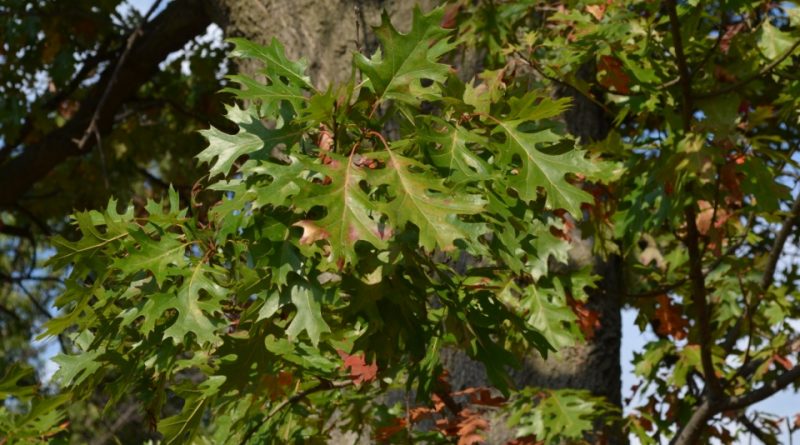Quercus coccinea
Quercus coccinea
The Scarlet Oak (Quercus coccinea Muenchh.) Is an arboreal species belonging to the Fagaceae family.
Systematic –
From a systematic point of view it belongs to the Eukaryota Domain, Kingdom Plantae, Magnoliophyta Division, Magnoliopsida Class, Fagales Order, Fagaceae Family and therefore to the Quercus Genus and to the Q. coccinea species.
Etymology –
The term Quercus comes from quercus, the Latin name of the oak, a plant sacred to Jupiter. The specific coccinea epithet derives from scarlet cóccinus: of scarlet color.
Geographic Distribution and Habitat –
The Scarlet Oak is a plant native to the central-eastern area of North America, where it forms mixed broad-leaved woods; its habitat is that of acid, shallow and dry soils. The species was introduced in Europe in the late 1600s, where it is used as an ornamental tree in parks and road trees.
Description –
Quercus coccinea is a tree that can reach 20 meters in height and has an expanded and elegant foliage, especially in old age. The trunk is straight and tends to widen in the old specimens, with first smooth rind, greyish and shiny, then brownish, wrinkled and furrowed vertically. The deciduous leaves, measuring up to almost 20 cm in length, are ovate-elliptic with lamina deeply incised in 3-4 pairs of toothed-aristate lobes; these, of a beautiful dark green on the upper page, in the autumn period assume a beautiful red color that tends to darken before falling. It has distinct male and female flowers; the male ones are arranged in catkins, while the female ones, single or in pairs, have a very short peduncle. The acorns mature in two years; they have a dome of 1-1.5 cm, a very short pericarp and almost completely covered by the involute edge of the dome.
Cultivation –
For the cultivation of the scarlet oak it is important to remember that they are plants that develop without problems in any position, preferring places with a good insolation; they are not afraid of the cold, although it may be necessary to repair the young specimens that have recently been placed in the shelter from the cold and the wind. Furthermore chlorosis can occur in calcareous soils. Regarding the water needs, the Quercus coccinea are satisfied with the rains, although they may need watering in case of long periods of drought during the summer months; as regards instead of very young specimens, recently placed in residence, need watering from March to September, to be supplied when the soil has been dry for some days.
For planting the plant it is necessary to plant the scarlet Oak in place with soft, loose, deep and very well drained soil, practicing a good sized pit, and working the soil in mixture with a little sand, little manure and a good amount of soft, permeable soil of good quality, to make sure that the new roots sink into a soil that is not too compact.
For its multiplication, in autumn it is possible to take cuttings of scarlet Oak, preferring the branches not yet completely lignified; in autumn it is also possible to sow the acorns, avoiding to cut them completely. Recall that the acorns do not germinate with great ease, it is therefore recommended to lightly scratch the surface with sandpaper, to allow water to penetrate inside them, also remember to sow more acorns, because the young oak shoots dry up with great ease.
Uses and Traditions –
The Scarlet Oak is a tree of easy cultivation, very common in America and in Europe; it is not very suitable for small gardens, even if there are dwarf varieties, with a more contained development. It is however very appezzata as an ornamental essence.
These trees generally tolerate the attack of parasites without problems, with the exception of the possibility of the presence of rodents and branching cancers, which under certain conditions can also compromise an entire plant. important is the choice of the land, very draining, to avoid rottenness; there are also some problems with attacks by parasites such as aphids and processionaries. Today, one of the main problems concerning this species is the “Oak Puzzle Disease” or decay syndrome. This is a general weakening of the plant, which manifests itself as a loss of leaves and the desiccation of the branches due, according to the most recent studies, to pollution, drought and changes in meteorological conditions in recent decades.
As for the quality of the wood, this is hard, low in tannins and easily rotten.
Preparation Mode –
Quercus coccinea is a species that is mainly used as an ornamental plant and has no other significant food or pharmaceutical uses.
Guido Bissanti
Sources
– Acta Plantarum – Flora of the Italian Regions.
– Wikipedia, the free encyclopedia.
– Treben M., 2000. Health from the Pharmacy of the Lord, Advice and experience with medicinal herbs, Ennsthaler Publisher
– Pignatti S., 1982. Flora d’Italia, Edagricole, Bologna.
– Conti F., Abbate G., Alessandrini A., Blasi C. (edited by), 2005. An annotated checklist of the Italian vascular flora, Palombi Editore.
Warning: Pharmaceutical applications and alimurgical uses are indicated for informational purposes only and do not in any way represent a medical prescription; there is therefore no liability for their use for curative, aesthetic or food purposes.


